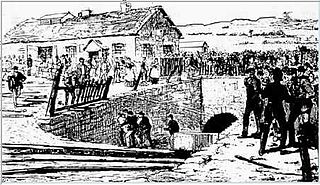
Porth is a town and a community in the county borough of Rhondda Cynon Taf, within the historic county boundaries of Glamorgan, Wales, lying in the Rhondda Valley and is regarded as the gateway to the Rhondda Fawr and Rhondda Fach valleys because both valleys meet at Porth. The Welsh word "porth" means "gate". Porth is a predominantly English-speaking community.

Abertridwr is a village in Caerphilly County Borough, Wales, situated about 3 miles (4.8 km) north-west of Caerphilly town.
Cwmfelinfach is a small village located in the Sirhowy valley of south-east Wales. It is part of the district of Caerphilly within the historic boundaries of Monmouthshire. Located north of Wattsville and about 5 miles north of the nearest town Risca and south of Blackwood.
Killay is the name of a suburb and local government community in Swansea, Wales. Killay has its own community council. The village is set high above sea level, about 3.5 miles west of Swansea city centre.
Wattsville is a small village in the Sirhowy Valley, eight miles north west of Newport, the county capital, in south-east Wales, within the historic boundaries of Monmouthshire.

Mining in Wales provided a significant source of income to the economy of Wales throughout the nineteenth century and early twentieth century. It was key to the Industrial Revolution.
Bedwas Navigation Colliery was a coal mine in the small Welsh village of Bedwas, two miles (3.2 km) north of Caerphilly. The colliery opened in 1913, and closed after the miners' strike of 1984-85.

Parc Slip Colliery was a coal mine near situated at Aberkenfig, near Tondu in Bridgend County Borough, Wales.
Windsor Colliery was a coal mine in the village of Abertridwr, Caerphilly.
Lady Windsor Colliery was a coal mine located in the village of Ynysybwl in South Wales. Opened in 1884, it closed in 1988, 104 years later.

Universal Colliery was a coal mine located in Senghenydd in the Aber Valley, roughly four miles north-west of the town of Caerphilly. It was in the county borough of Caerphilly, traditionally in the county of Glamorgan, Wales.
Abercynon Colliery was a coal mine located in Abercynon, South Wales. Opened in 1889, it closed in 1988.
Cynheidre Colliery was a coal mine located in the Gwendraeth valley, in Carmarthenshire, South Wales. Opened in 1954, it closed in 1989.

The Cambrian Colliery was a large coal mine that operated between 1872 and 1967 near Clydach Vale in the Rhondda Valley, south Wales. It is notable for its huge production and for two infamous explosion disasters, in 1905 and 1965, in which a total of 64 miners were killed. Its owners sank the first pits into a rich coal seam in the 1870s from which, within 20 years, over 700 tons were being extracted daily. The complex was connected to the Taff Vale Railway and had room in its sidings for over 840 wagons. The colliery's workforce, which numbered over 4,000 in 1913, was prominently involved in the Tonypandy Riot of 1910.

Six Bells Colliery was a coal mine located in Six Bells, Abertillery, Monmouthshire, Wales. On 28 June 1960 it was the site of an underground explosion which killed 45 local miners. It is now the site of an artistically acclaimed memorial to those events, designed by Sebastian Boyesen, and although the memorial is primarily to those who died in Six Bells, it also commemorates human losses and the hope of the entire South Wales coalfield.
The Tarenni Colliery and its associated workings, are a series of coal mines and pits located between the villages of Godre'r Graig and Cilybebyll located in the valley of the River Tawe, in Neath Port Talbot county borough, South Wales.

Deep Navigation Colliery was a coal mine in South Wales, that operated from 1872 until 1991.
Abernant Colliery was a coal mine in the River Amman valley at Pwllfawatkin, 4 miles (6.4 km) north of Pontardawe and 13 miles (21 km) north of Swansea, West Wales.

Great Western Mine, also known as Hetty Pit, was a coal mine, at Hopkinstown, near Pontypridd, Glamorgan in South Wales.
The Abercarn colliery disaster was a catastrophic explosion within the Prince of Wales Colliery in the Welsh village of Abercarn, on 11 September 1878, killing 268 men and boys. The cause was assumed to have been the ignition of firedamp by a safety lamp. The disaster is the third worst for loss of life to occur within the South Wales Coalfield.